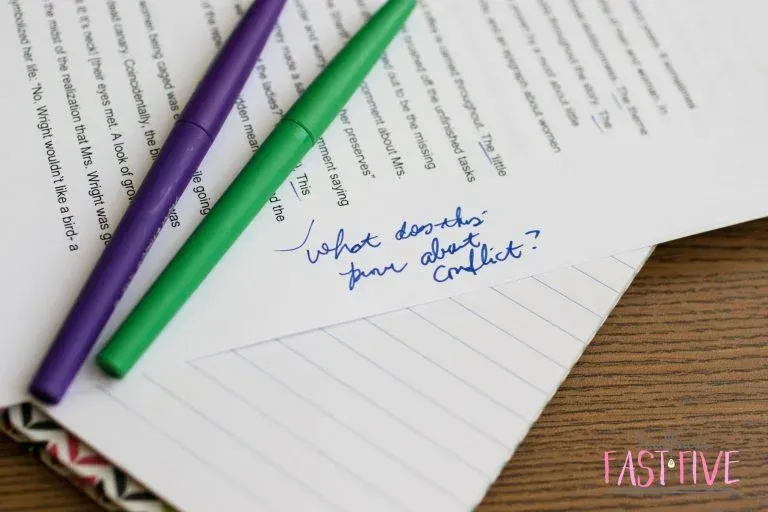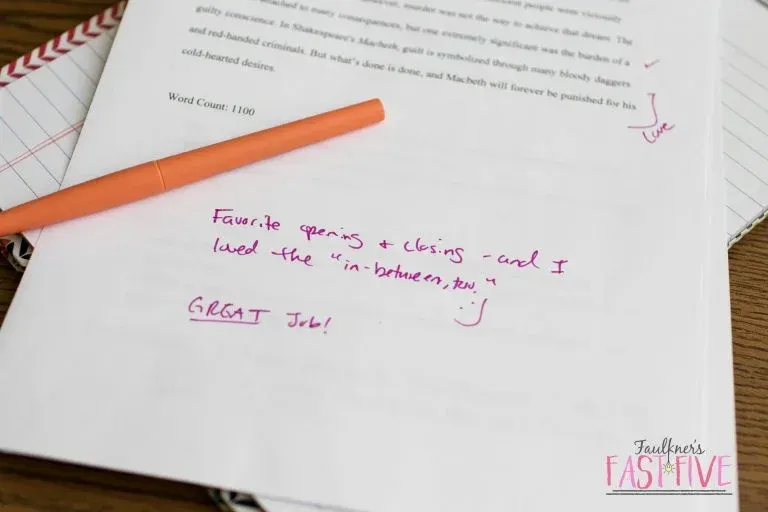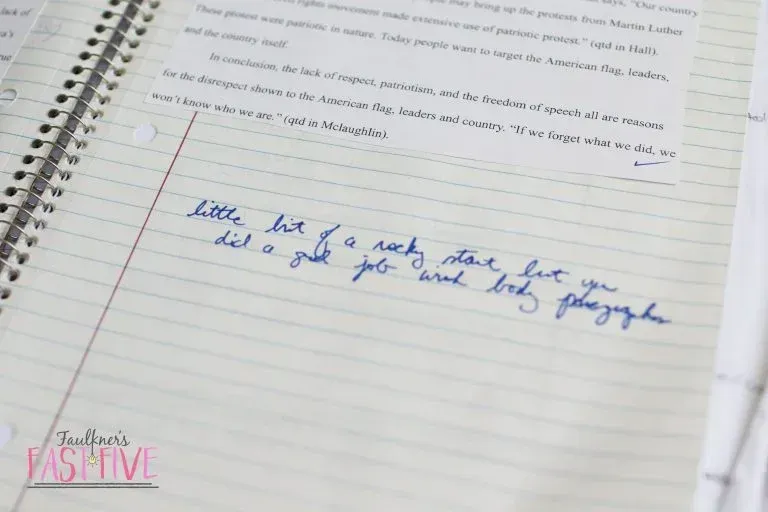A Formula for Successful Writing Instructions Series #5 Finishing Up
Since this phase represents the end of the process and everything that occurs after the paper has been completed, I like to call this phase the “after party.” It really works, too, if you think about because the accomplishment of writing should be celebrated!
1.
Meaningful feedback is key in teaching students to truly look at what they’ve written after the fact. I want my students to know that I’ve read what they’ve written and taking the time – yes quite a bit of time – to write something meaningful on each paper is part of that process. I always try to leave notes for both strengths and targets for students throughout the essay. Those notes are tailored to each student’s abilities, too. For some students, I’ll ask a question to prod more thinking, but with other students, I’ll be more direct.
I also include a note at the end that is personal and lets students know that I appreciate the work they’ve done. This is also a good place to let students know that you’ve noticed their growth. The of end-of-essay “letter” serves as a mini conference that gives students a little boost of confidence for the next task.
2.
Student self-evaluation is another piece of the process that I believe produces amazing – if not the best – results for growth. We, as writing teachers, all know that we spend hours grading, scoring, and commenting just to have students glance at the grade when we hand the essays back and then shove it in their binder or file it away in some random Google folder. I needed students to read what I wrote and take an honest look at what they had done, so I developed self-evaluation forms for writing. I’ve blogged about these little jewels before because I believe in them so much. On the day I hand the essays back, I make class time for students to fill out the forms. Sometimes I give a grade for the forms, and other times I give a few extra credits points on the essay grade. Students to respond really well to the forms, and I love seeing them dig back through their work learning to look for triumphs and issues.
3.
Sharing successes and student exemplars when possible builds morale and confidence. (The process must be done tactfully, and anytime I share student work from within the class I always take the names off, of course.) I always try to choose a different student’s work each time, and even if it’s not an entire essay, – maybe just the opening or a paragraph that was done particularly well – it is still very beneficial for the entire class to see how different students responded to the task. If it’s an argumentative task we just finished, I try to choose responses that were well done from each stance. I always explain specifically what was well done about the paper I’m showing. Often, I choose different traits to focus on in the exemplars when I’m sharing throughout the semester. I also remind students that they may see those same traits in their own papers, and if not, then they know what they need to work on next time. I don’t hang up student essays in my room or hallways, but students are required to keep the tasks in their writer’s portfolio. That satisfies the “publishing” feel of the process for high school students.
4.
Keeping a chart of writing scores is an excellent exercise for those math-minded students, and it makes the perfect organic data collection evidence for you. My writing curriculum has the tools you need in it to make this part of the process a staple.
5.
Allowing students to revise every essay for a fresh, new grade can seem like a huge task, especially if you have 100+ students. You spend hours grading through them the first time around, so how could you possibly consider grading them again? Many colleges encourage professors to develop a revision policy, and I think it is another piece of the process that does produce growth. After students have completed the self-evaluation form, and they know what to look for in terms of issues, their revisions really can be worthwhile. When I taught at the college level, I allowed students to revise and resubmit one essay. I know others who allowed students to revise and resubmit all of them. I kept the revise and resubmit one essay policy when I moved to high school. Along with that essay, they had to submit their original essay and a cover letter explaining what changes had been made and why. Also, I always score grammar separately from the content, and while they should make changes to the grammar in the revision, I never change that grade. I do, however, see improved grammar scores as we go. Lastly, when students submit a revision, I completely replace that new grade. Other caveats of my policy include *no late essays can be revised *essays not meeting word requirements cannot be revised, etc. I like giving students a chance to put those commitments from the self-evaluation forms into practice, but I also know I can’t drive myself crazy with so much grading nonstop. The more revising, the more growth, but you have to protect yourself in the process, too.
I hope this writing series has provided you with the tools and direction you need to get started on a healthy and effective writing program in your own classroom. Just joining me for this post? See the others in this series here:
You can see Post #1 of this series here (Teacher Prep Planning).
You can see Post #2 of this series here (Writer’s Portfolio).
You can see Post #3 of this series here (The RACE paragraph).
You can see Post #4 of this series here (The Writing Process).
I also encourage students to use an online software or program that edits like Grammarly or Paperrater. These will give students free and fast information about what they should correct. I also worn students that there is nothing better than the human eye, so it’s important they do their own proofreading and maybe have our early morning English tutor look over it, too.
Remember that the process is just that – a process. That process can look different for each student and each classroom. It’s the struggle through that is productive and produces great writers.
You can see Post #1 of this series here (Teacher Prep Planning).
You can see Post #2 of this series here (Writer’s Portfolio).
You can see Post #3 of this series here (The RACE paragraph).
Love this content?
Sign up for my email newsletter with more tips, ideas, success stories, and freebies!






















